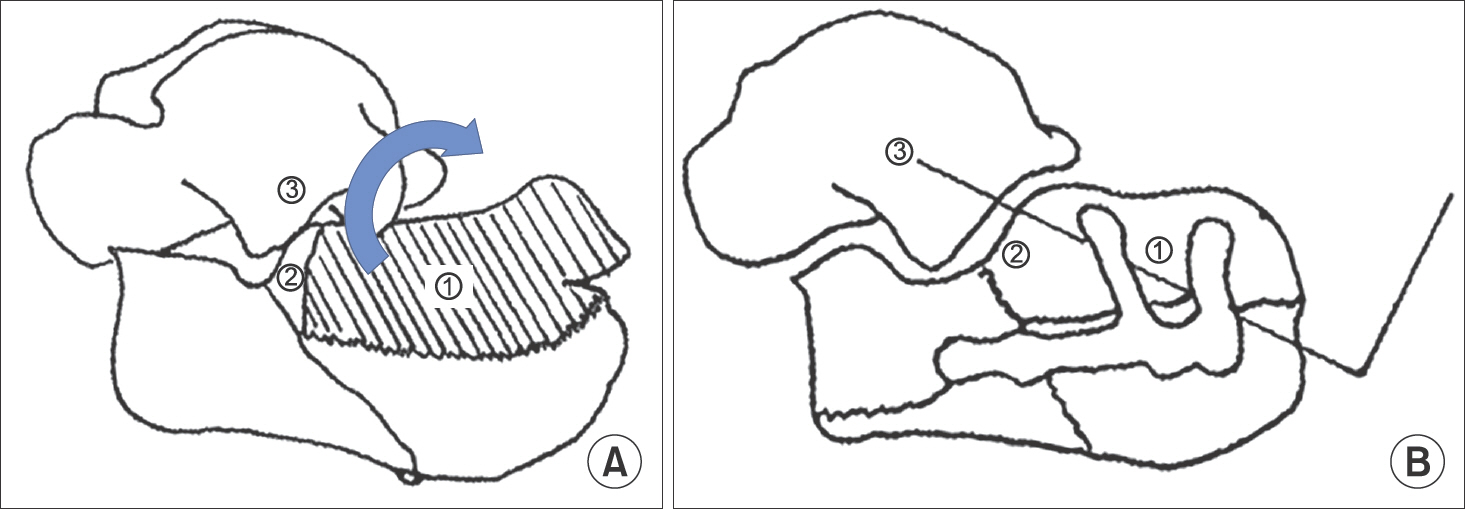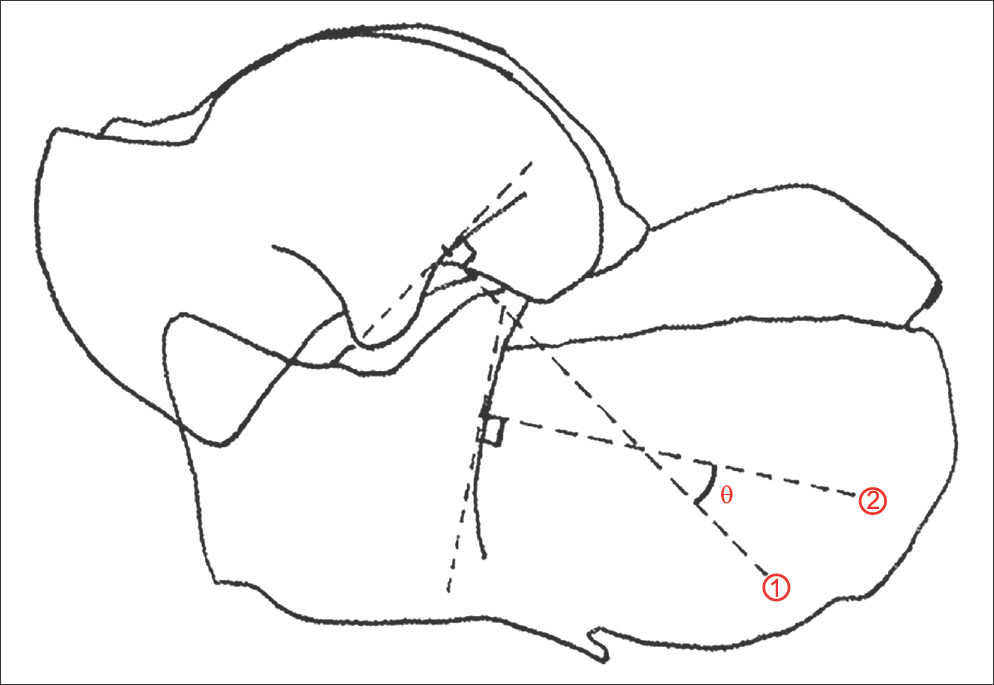J Korean Foot Ankle Soc.
2014 Sep;18(3):119-123. 10.14193/jkfas.2014.18.3.119.
The Effect of Temporary K-wire Fixation in the Plate Fixation for Displaced Intra-articular Calcaneal Fracture
- Affiliations
-
- 1Surgery of Foot and Ankle, Eulji General Hospital, Eulji University College of Medicine, Seoul, Korea. doctorjs@eulji.ac.kr
- KMID: 2333478
- DOI: http://doi.org/10.14193/jkfas.2014.18.3.119
Abstract
- PURPOSE
This study was designed to evaluate the clinical efficacy of temporary K-wire fixation in F-plate fixation for displaced intraarticular calcaneal fractures.
MATERIALS AND METHODS
Two groups (group 1 with F-plate fixation only and group 2 with temporary K-wire fixation and F-plate fixation) of patients were included in this study. The temporary K-wire was removed six weeks after the operation. Each group consisted of 33 cases. Rotational axis angles were measured radiographically and the foot and ankle outcome score (FAOS) was used for clinical assessment.
RESULTS
In group 1, the mean rotational axis angle was reduced from 27degrees preoperatively to 5.59degrees postoperatively and the angle at last follow-up was 9.94degrees. There was an increase in angle of 4.35degrees between postoperative and the last follow-up measurement. In group 2, the mean rotational axis angle was reduced from 21.2degrees preoperatively to 4.39degrees postoperatively and the angle at last follow-up was 5.91degrees. There was an increase in angle of 1.52degrees between postoperative and the last follow-up measurement. Significant difference in the changes of rotational axis angle was observed between the two groups. However, no significant difference in FAOS was observed between the two groups.
CONCLUSION
Temporary K-wire fixation can prevent reduction loss when treating displaced intra-articular calcaneal fractures with an F-plate.
MeSH Terms
Figure
Reference
-
1.Tomesen T., Biert J., Frölke JP. Treatment of displaced intra-articular calcaneal fractures with closed reduction and percutaneous screw fixation. J Bone Joint Surg Am. 2011. 93:920–8.
Article2.Sanders R. Displaced intra-articular fractures of the calcaneus. J Bone Joint Surg Am. 2000. 82:225–50.
Article3.Bae SY., Shin YK., Kim JO., Lee JH., Lee CW., Shin JH. Evaluation of rotational displacement of the posterior facet on the sagittal plane in computed tomographic images of calcaneal fractures. J Korean Fract Soc. 2005. 18:165–9.
Article4.Roos EM., Brandsson S., Karlsson J. Validation of the foot and ankle outcome score for ankle ligament reconstruction. Foot Ankle Int. 2001. 22:788–94.
Article5.Crosby LA., Fitzgibbons T. Computerized tomography scanning of acute intra-articular fractures of the calcaneus. A new classification system. J Bone Joint Surg Am. 1990. 72:852–9.
Article6.McLaughlin HL. Treatment of late complications after os calcis fractures. Clin Orthop Relat Res. 1963. 30:111–5.7.Paley D., Hall H. Intra-articular fractures of the calcaneus. A critical analysis of results and prognostic factors. J Bone Joint Surg Am. 1993. 75:342–54.
Article8.Buckley R., Tough S., McCormack R., Pate G., Leighton R., Petrie D, et al. Operative compared with nonoperative treatment of displaced intra-articular calcaneal fractures: a prospective, randomized, controlled multicenter trial. J Bone Joint Surg Am. 2002. 84:1733–44.9.Mulcahy DM., McCormack DM., Stephens MM. Intra-articular calcaneal fractures: effect of open reduction and internal fixation on the contact characteristics of the subtalar joint. Foot Ankle Int. 1998. 19:842–8.
Article10.Yang KH., Park YH., Won JH., Kim DY. Mechanical properties of f plate in intraarticular calcaneal fractures. J Korean Fract Soc. 2004. 17:167–72.
Article11.Ball ST., Jadin K., Allen RT., Schwartz AK., Sah RL., Brage ME. Chondrocyte viability after intra-articular calcaneal fractures in humans. Foot Ankle Int. 2007. 28:665–8.
Article
- Full Text Links
- Actions
-
Cited
- CITED
-
- Close
- Share
- Similar articles
-
- Management of Displaced Intra-articular Calcaneal Fracture
- Open Reduction and Internal Fixation with AO Calcaneal Plate for Displaced Intra-articular Calcaneal Fracture
- Avulsion Fracture of Calcaneal Tubercle Treated with Cannulated Cancellous Screws and Wire: Surgical Technique
- Mechanical Properties of F Plate in Intraarticular Calcaneal Fractures
- Surgical Treatment of Displaced Intra-articular Fracture of the Calcaneus using a Y-plate




